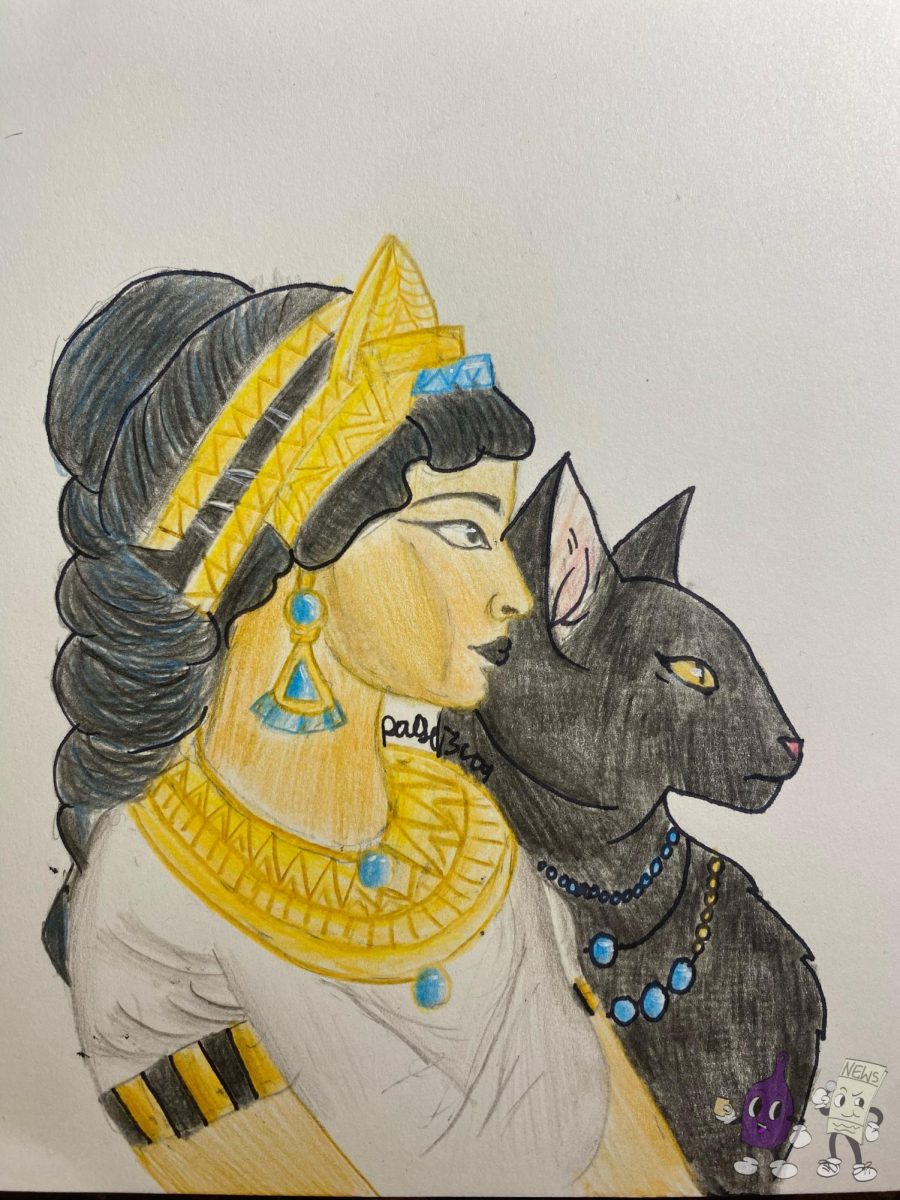When the topic of the first written language comes up, most people’s first thought goes to ancient Egypt. Egyptian art was one of the original major artistic and academic movements, and the beginning of permanent architecture.
Egyptian art varies from other ages in many ways. The style of the art in all its forms is very blocky, abstract, and distinctly opposed to art of the Renaissance or modern eras.
The way the art was used also differed greatly, in later ages, artwork was for all people of all social standings despite frequently being owned by the wealthy. However, in ancient Egypt, art was created for the dead. The art seen in most museums are from royal and elite studios. Smaller and less elaborate pieces such as amulets, coffins, and statues, though not often shown in museums, could be found in the homes of lower-class people.
All of the art that the ancient Egyptians created was made out of resources they could obtain easily. In a country that is primarily made up of sand, they were unable to obtain dyes in the same way that many prehistoric humans would have with berries and trees. However, despite living in the desert, one thing they did have was water.
The Nile river had a massive impact on the way that ancient Egyptians lived. It helped them to access resources through trade such as woods from Syria and metals from the far east. The river also provided a way to get materials that are created in flowing water: limestone, calcite, and sandstone. They used these materials in statues, slabs for writing, and the construction of buildings. Metals were frequently used in jewelry and tableware, and woods were used to make statues and sarcophagi.
Limestone and Sandstone were famously used in what is the most well known form of Egyptian art, the Great Pyramids. How the pyramids were first built has not been fully uncovered by archaeologists, however, they have some ideas. Many people would set to work retrieving stones from quarries. They would then transport them in carts, rafts, or by hand to make them into massive bricks. The way that they got the bricks into a pyramid shape is the biggest mystery of their construction. It could have been pulleys, ramps, or something not yet discovered.
The great pyramids of Giza were built out of stones from a stone pit called the Khufu Quarry. The quarry was named after Khufu, the pharaoh at the time the pyramids were first built. They were created in the area of Giza for a few reasons, one being that the land was mostly flat. It was also easy to retrieve stone from the ground there, and because of its placement to the west of the Nile, in the land of Anubis, the Egyptian god of the dead.
Underneath the pyramids were the tombs of dead pharaohs. While they were still alive, the pharaohs would have workers create burial chambers for their final resting place. The chambers would be filled with the pharaoh’s possessions and art from their life. It is thought that the art in tombs created a link between the life and death of the people in the tombs. The art that was created to be there was never meant to be seen; it was made for the gods to know about the soul of the deceased.
In the tombs, there would often be hieroglyphics carved into the stone walls. The writing would often be stories of the dead’s life or prayers written to guide them to the afterlife.
Hieroglyphics have many similarities to cave paintings, such as them both being made up of drawings of animals and objects that would have been seen by the people in the area. However, hieroglyphics have one glaring difference, they have been almost entirely decoded.
In 1799, Napoleon Bonaparte invaded Egypt. With him, he brought both soldiers and scholars. They surveyed the country and discovered a broken stone that translated hieroglyphics into Greek and demotic. The stone was titled the Rosetta Stone.
Not long after the Rosetta Stone was created, in 196 B.C.E., Egypt began to be invaded by many nearby countries, Greece being the main one. Steadily after the Greeks arrived in Egypt, they shifted the Egyptian languages into Greek and Coptic. Because of this, the ability to speak and read Egyptian slowly vanished.
Along with Napoleon Bonaparte, Jean-François Champollian was paramount to deciphering hieroglyphics. When he was seventeen, he began to learn Coptic, and in doing so, he found that it had many similarities to what was already known of the Egyptian language at the time. He and many other scholars were racing to discover the secret behind the drawings.
Once the Rosetta Stone was discovered, the scholars were given what was found to be the key to deciphering hieroglyphs; the only thing stopping them was trying to interpret whether the drawings were phonetic or ideographic.
Phonograms are symbols that signify different sounds or tones, much like individual letters. Ideograms are pictures that mean specific things and words, such as a picture of a house that means house, and the word pr in Egyptian, also meaning house.
Champollian came to a conclusion that no one else had been able to, hieroglyphs weren’t either phonetic or ideographic, but both. Hieroglyphs, like cave paintings, had many symbols and drawings, however, with hieroglyphs some of them meant words and some only meant sounds. “Egyptian hieroglyphics were subdivided into categories including phonograms and ideograms” said Martin Hosie in his article “Ancient Egyptian hieroglyphs”.
Another staple of artistic expression that came about with the ancient Egyptians was fashion. While clothing was still fairly plain, there was variety between men and women’s clothing, and specific jobs had different ways of dressing. An upper class woman traditionally wore a plain dress with straps on her shoulders or a long sleeve; a common man or woman would wear a simple loin cloth or long skirt. Almost everyone would go about their days without shoes for hundreds of years.
The clothing of the lower class would have been made out of cotton, linen, or flax, and would have been a light color such as white or beige. Upper class citizens would wear similar clothing in a similar fashion but would be adorned with jewelry and accessories. Children of the upper and lower classes wore no clothing for the first few years of their lives, often not beginning to wear clothing until they hit puberty.
Egyptian fashion remained the same for many years and only started to change slightly in the middle kingdom (2040-1782 BCE). While women used to wear their hair to their ears, in the middle kingdom, they started to wear it down to their shoulders. Upper class women in the middle kingdom wore more elaborate dresses with deeper necklines, clasp necklaces, and ornamented belts.
Despite taking place so long ago, ancient Egypt has affected so much of modern day. Not just art, but mathematics, sciences, and literature have all been majorly affected.




